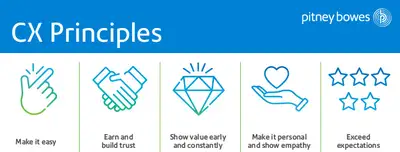Fundamental to ongoing business success: Earning and building trust
I am passionate about the impact of a positive client experience (CX) — it is an essential element to successful business relationships. Being passionate about CX isn’t enough. We need to demonstrate to our clients that every interaction with them is important to their business.
At Pitney Bowes, we focus on five core CX principles.

This year to mark global CX Day, I spoke with Susan Mitchell Smith (Director of eCommerce new business — Mid-Atlantic) on how we earn and build trust with our clients. It was an exciting conversation for both of us because it demonstrated our shared commitment to our clients. Here are some highlights.
Fundamental to our ongoing business success: Earning and building trust
On the heels of our transformation into shipping and ecommerce logistics, ensuring we have the trust of our clients is key to our next chapter.
We’re a shipping AND mailing AND financial services company, today, and we’ve worked hard over the past 100 years to build trust and guide our clients through change in our industry, solving challenges together.
So, how do you build this trust? You become a partner.
Susan and I agreed that a successful CX focused business will:
1. Adapt and be flexible
A relationship between two companies is like a relationship between two people. You not only have to listen to what they say but also be flexible and willing to adapt to what you are hearing.
We are constantly listening to how our clients value our products and services and adapting to the feedback via numerous survey mechanisms. We need to anticipate a client’s future needs and deliver solutions that will adapt to their growing business.
Listen. React. Change.
2. Build confidence
In speaking with Susan, I was inspired by her approach to building client relationships. She expressed that once you’ve heard the client, it is important to walk in their shoes; only then will you truly understand and empathize with them and, in turn, build their confidence. Saying sorry and admitting mistakes shows we have the clients’ back and opens a dialogue on how we can improve.
When looking to fix a client issue, pair humanity with action.
3. Focus on client need
Susan and I have learned that no two clients are the same.
You need to develop innovative ways to capture who your clients are and how they interact with your business and your product. Learn about their business, their workflows, their objectives, and what success looks like to them. Understand their pain points and make them your own. It’s through our commitment to increasing our awareness of client needs and aspirations that we can let them shine and exceed expectations.
Invest the time and meet them on their level.
I’ll leave you with two thoughts.
First, it never gets old to be client centric.
Second, people don’t care how much you know until they know how much you care — and then, as soon as they know how much you care, they care how much you know.
Don’t undervalue the trust you can build with a client.
